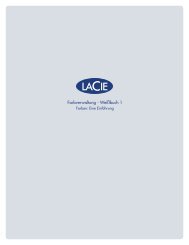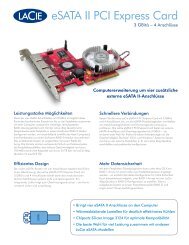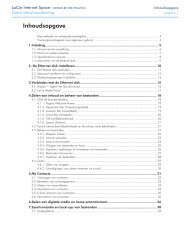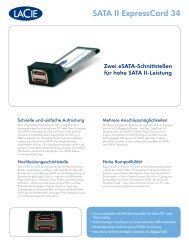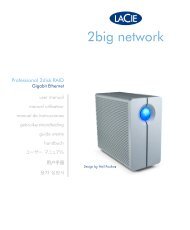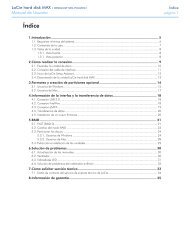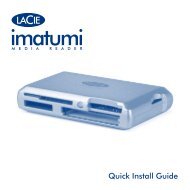Download PDF LaCie D2 Quadra Hard Drive
Download PDF LaCie D2 Quadra Hard Drive
Download PDF LaCie D2 Quadra Hard Drive
You also want an ePaper? Increase the reach of your titles
YUMPU automatically turns print PDFs into web optimized ePapers that Google loves.
<strong>LaCie</strong> d2 <strong>Quadra</strong><br />
Glossary<br />
Quadruple Interface <strong>Hard</strong> <strong>Drive</strong> page<br />
Glossary<br />
Asynchronous – Data transfer method where the data is<br />
transferred independently of other processes. With this<br />
transfer method, the intervals between transmissions<br />
can vary, and data can be resent if it is initially missed.<br />
Backup – (1) The act of creating at least one additional<br />
copy of data onto a different (and safe) storage device<br />
from where it can be retrieved at a later time if needed.<br />
(2) A copy of a file, directory, or volume on a separate<br />
storage device from the original, for the purposes of retrieval<br />
in case the original is erased, damaged, or destroyed.<br />
Bit – The smallest measure of computerized data, either<br />
a 1 or a 0. Eight bits equal one byte, or one character.<br />
Block – A very small section of the storage media comprised<br />
of one or more sectors. A block is the smallest<br />
amount of space allocated on a drive for data storage. By<br />
default, a sector of data consists of 512 bytes.<br />
Buffer – RAM cache that is faster than the data that is<br />
being delivered. Buffers are used so data may be stored<br />
and delivered to the receiving item as it is needed.<br />
Bus – Electronic links that enable data to flow between<br />
the processor, RAM and extension cables (peripherals).<br />
Byte – A sequence of adjacent binary digits, or bits, considered<br />
as a unit, 8 bits in length. There are 8 bits in 1<br />
byte. See also MB (Megabyte) or GB (Gigabyte).<br />
Cache, -ing – This is an area of electronic storage (usually<br />
RAM) set aside to store frequently used data from<br />
electromechanical storage (hard drives, floppy disks,<br />
CD/DVD-ROM, tape cartridges, etc.) Therefore, storing<br />
frequently used data in RAM can enhance your<br />
system’s overall response to disk-intensive operations<br />
significantly.<br />
Configuration – When talking about a PC, configuration<br />
is understood to be the sum of the internal and<br />
external components of the system, including memory,<br />
disk drives, the keyboard, the video subsystem and other<br />
peripherals, such as the mouse, modem or printer. The<br />
configuration also implies software: the operating system<br />
and various device managers (drivers), as well as<br />
hardware settings and options set by the user via configuration<br />
files.<br />
Controller – This is a component or an electronic card<br />
(referred to in this case as a “controller card,” such as<br />
PCI or PCMCIA cards) that enables a computer to<br />
communicate with or manage certain peripherals. The<br />
controller manages the operation of the peripheral associated<br />
with it, and links the PC bus to the peripheral via<br />
a ribbon cable inside the PC. An external controller is<br />
an expansion card which fills one of the free slots inside<br />
your PC and which enables a peripheral (CD-ROM<br />
drive, scanner or printer, for instance) to be connected<br />
to the computer.<br />
Cross-platform – Term that refers to a device that is<br />
able to be operated by both Mac and Windows operating<br />
systems.<br />
Data Stream – The flow of data that accomplishes a task,<br />
usually related to moving data from storage to computer<br />
RAM or between storage devices.<br />
Digital – Discrete information that can be broken down<br />
to zero or one bits.<br />
<strong>Drive</strong>r (peripheral manager) – A software component<br />
that enables the computer system to communicate with<br />
a peripheral. Most peripherals will not operate correctly<br />
– if at all – if the appropriate drivers are not installed on<br />
the system.<br />
File System – Links the physical map of a disc to its<br />
logical structure. Thanks to the file system, users and<br />
computers can easily display path, directories and files<br />
recorded onto the disc.<br />
Firmware – Permanent or semi-permanent instructions




